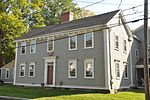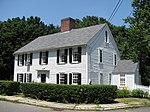Nathaniel Rust Mansion

The Nathaniel Rust Mansion is a historic house at 83 County Street in Ipswich, Massachusetts. It is a 2+1⁄2-story colonial style house with First Period origins, indicated in part by its asymmetrical front facade. The date of its construction is uncertain; the first record of the house is its sale by Deacon William Goodhue to Nathaniel Rust, a tanner, in 1665. It was for many years located on the South Green, but was moved to its present location on County Street in 1837 by Asa Brown. Brown at the same time made modifications to the house, giving it its Federalist character. The house is one of the oldest houses in Ipswich that is situated outside one of its central historic districts.The house was listed on the National Register of Historic Places in 1980.
Excerpt from the Wikipedia article Nathaniel Rust Mansion (License: CC BY-SA 3.0, Authors, Images).Nathaniel Rust Mansion
County Road,
Geographical coordinates (GPS) Address Nearby Places Show on map
Geographical coordinates (GPS)
| Latitude | Longitude |
|---|---|
| N 42.6725 ° | E -70.8375 ° |
Address
County Road 85
01938
Massachusetts, United States
Open on Google Maps











